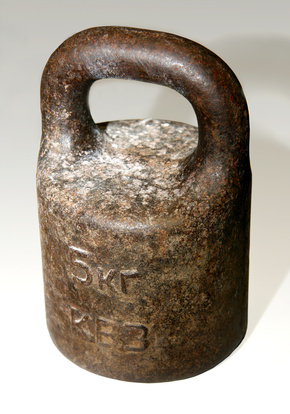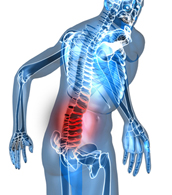Tight Hip Flexors and Low Back Pain
If you are suffering from Low Back Pain, or pain in the Hip Flexors(Tight Hip Flexors) in general, this post and these videos will help you with loosening them up. Lower back muscle imbalances caused by sitting, typing and looking at your monitor too much can set you up for chronic problems throughout the body, but are a major concern in the lower back area.

Old Russian Kettlebell
While sitting, the hip flexors remain shortened and hyperactive, and over a period of time, this becomes a chronic condition. In the meantime, the muscles in the buttocks (the gluteus maximus, gluteus medias and gluteus minimus, also referred to as the glutes), remain stretched and inactive, eventually causing them to become weak and non-responsive.
Tight hip flexors draw the pelvis forward, and weak glutes are unable to counteract that forward pull, causing the low back to arch into a swayback position. This arching of the low back can cause low back pain, and sciatica.
These two conditions can lead to such low back pain that it has driven many people to pain medication and eventual addiction. We want to avoid that, so we are going to stretch those hip flexors, and tighten those glutes.
Three Simple Tests
- Tight hips and flexors – These are the muscles and tendons in the front of your hips. This simple test will tell you if you have tight hip flexors. Lie on your back and pull one knee to your chest while keeping the other leg extended and flat against the floor. If that extended leg comes up off the floor as your bent knee approaches your chest, you have tight hip flexors. Do this for both sides.
- Tight hip rotators – Hip rotators are found deep within the hip. These are very important muscles for health and performance. Sit in a chair with your back straight, cross your right leg over your left knee, placing the outside of your right foot on your left knee/thigh. If your right knee sticks up in the air and doesn’t sit parallel with the floor, or close to parallel, then you probably have tight hip rotators. Do this for both sides.
- Glutes or Buttocks(the gluteus maximus, medias and minimus) – If you have weak or inactive glutes, this means your hamstrings are doing all of the work. Most people who have desk/sitting jobs or sit for the majority of the day will have this problem. This leads to tight and strained hamstrings, hip pain, low back pain, and a whole lot of other problems, including minimal strength levels for training. One way to tell if you have weak or inactive glutes is to lie on your back with your knees bent and your feet flat on the floor. While lying, with your back flat against the floor, use your heels to elevate your hips. Do this motion for about 20 straight repetitions. If you feel a burning and/or tightness in your hamstrings more so than in your glutes (buttocks), then your glutes are not working as they should.







